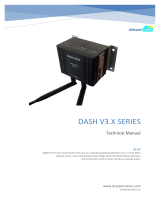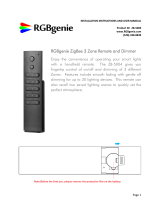
Design notes
XBee ZNet 2.5 / XBee PRO Znet 2.5 OEM RF Modules Product Manual 12
Notes:
• Minimum connections: VCC, GND, DOUT and DIN
• Minimum connections to support serial firmware upgrades: VCC, GND, DIN, DOUT, RTS and DTR
• Signal Direction is specified with respect to the module
• Module includes a 10k resistor attached to RESET
• Several of the input pull-ups can be configured using the PR command
• Unused pins should be left disconnected
• Pin 20 can be connected to a push button (pin grounded when closed) to support the
commissioning push button functionality. See Network commissioning and diagnostics on
page 54 for details.
Design notes
The XBee modules do not specifically require any external circuitry or specific connections for proper
operation. However, there are some general design guidelines that are recommended for help in
troubleshooting and building a robust design.
Power supply design
Poor power supply can lead to poor radio performance especially if the supply voltage is not kept
within tolerance or is excessively noisy. To help reduce noise a 1uF and 8.2pF capacitor are
recommended to be placed as near to pin1 on the PCB as possible. If using a switching regulator for
your power supply, switching frequencies above 500kHz are preferred. Power supply ripple should
be limited to a maximum 250mV peak to peak.
Note An additional 10uF decoupling cap is recommended near pin 1 of the module for designs
using the programmable modules. The nearest proximity to pin 1 of the 3 caps should be in
the following order: 8.2pf, 1uF followed by 10uF.
Recommended pin connections
The only required pin connections are VCC, GND, DOUT and DIN. To support serial firmware updates,
VCC, GND, DOUT, DIN, RTS, and DTR should be connected. Other pins may be connected to external
circuitry for convenience of operation.
All unused pins should be left disconnected. All inputs on the radio can be pulled high with 30k
internal pull-up resistors using the PR software command. No specific treatment is needed for
unused outputs.
For applications that need to ensure the lowest sleep current, inputs should never be left floating.
Use internal or external pull-up or pull-down resistors, or set the unused I/O lines to outputs.
20 AD0 / DIO0 / Commissioning
Button Either Analog Input 0, Digital IO 0, or Commissioning Button
Table 2: Pin assignments for the XBee PRO ZNet 2.5 Modules. Low-asserted signals are distinguished with a
horizontal line above signal name.
Pin # Name Direction Description





















